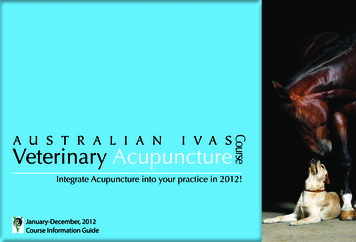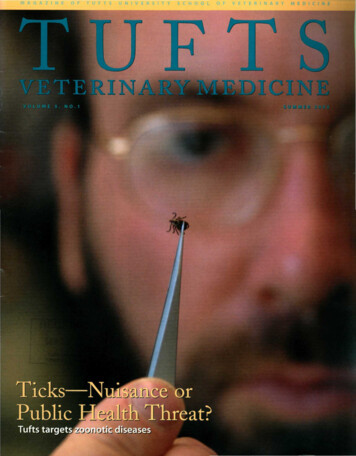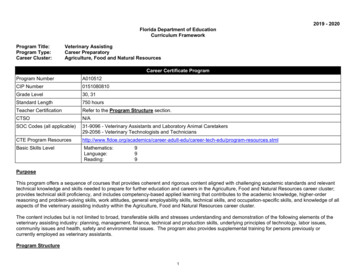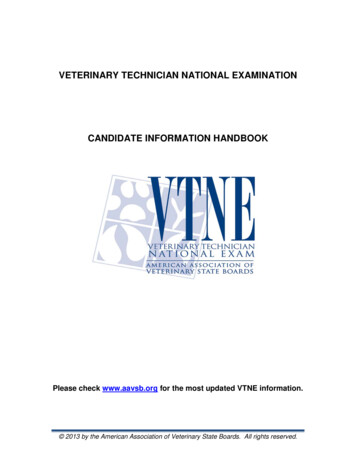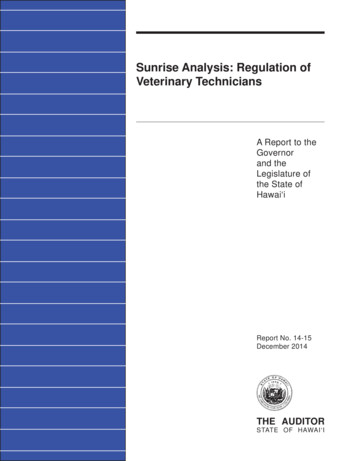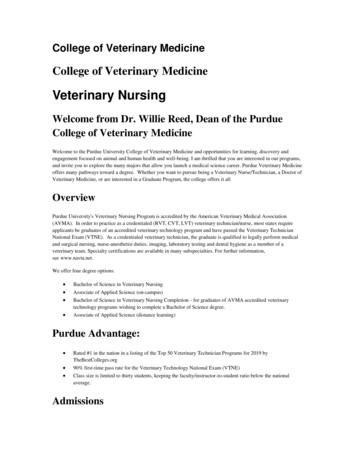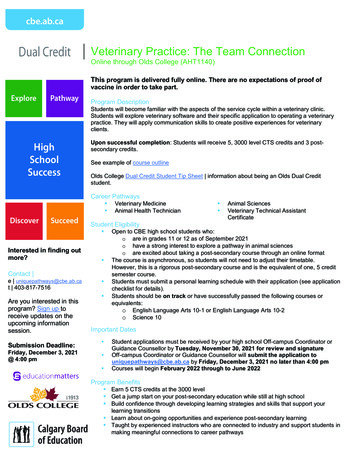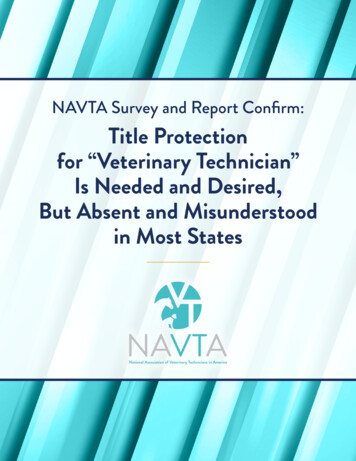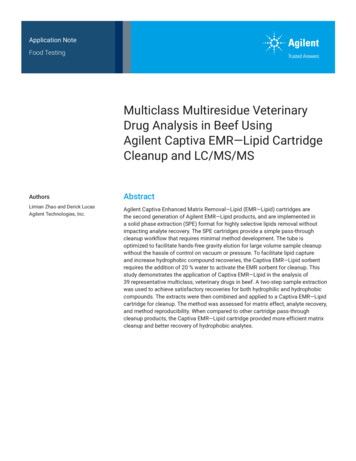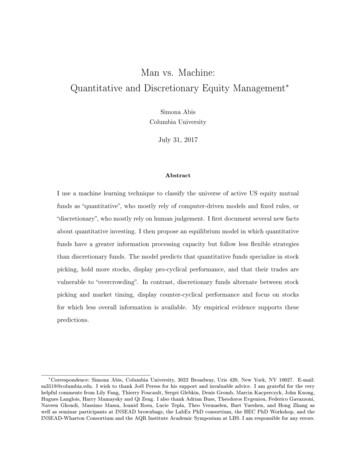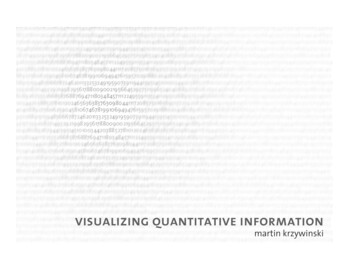
Transcription
Application NoteFood Testing andAgricultureQuantitative Screening of MultiresidueVeterinary Drugs in Milk and EggUsing the Agilent 6495C TripleQuadrupole LC/MSAuthorsSiji Joseph, Aimei Zou,Limian Zhao, Patrick Batoon,and Chee Sian GanAgilent Technologies, Inc.AbstractThis application note demonstrates the use of the Agilent ComprehensiveVeterinary Drug dMRM Solution for the screening of 210 target residues in milk andegg matrices. The workflow specifies conditions for chromatographic separation,MS detection, and data processing, using a slightly modified sample preparationprocedure. Workflow performance was assessed based on limit of detection (LOD),limit of quantitation (LOQ), calibration curve linearity, accuracy, precision, recovery,and repeatability. Over 93% of veterinary drugs showed LOD of 1 μg/kg in milksamples. Calibration curves for all targets ranged from the LOQ to 100 μg/kg witha coefficient of correlation (R2) 0.99. Target peak area response (%RSD) was 15%, and retention time (RT) %RSD was 0.5%. Method accuracy values, based onmatrix-matched calibration were within 87 to 117%. The average recovery of 95%of targets was within 60 to 120%, with repeatability %RSD of 15%. Both milk andegg matrices showed similar quantitative results. Injection-to-injection robustnessresults demonstrated excellent target peak area and RT reproducibility across400 injections, confirming the workflow capability for routine multiresidue screeningwith large-scale sample sets.
IntroductionThe Agilent Comprehensive VeterinaryDrug dMRM Solution is an end-to-endworkflow solution for targeted screeningor quantitation of 210 veterinary drugresidues in animal origin matrices,which accelerates and simplifies routinelaboratory testing. The solution includescomprehensive sample preparation,chromatographic separations,optimized MS detection methodconditions, data analysis methods, andreporting templates for 210 veterinarydrugs in various food matrices. TheComprehensive Veterinary Drug dMRMSolution minimizes method developmenttime and combines multiple foodmatrix analyses into one easy-to‑followprotocol. Agilent MassHunter dataacquisition software, together withthe dMRM database offers easycustomization of dMRM submethodsbased on preferred target list orregulation, as determined by the user.The solution is available and has beenverified with two mass spectrometers(Agilent 6470 triple quadrupole LC/MSand the Agilent 6495C triple quadrupoleLC/MS) to address diverse sensitivitydemands based on the choice of samplematrix and specific regulations thatvary globally.The solution was originally developedfor the quantitative screening of210 multiclass veterinary drugs inchick, beef, and pork.1 It was thendemonstrated to be effective forseafood using salmon and shrimp asexample matrices.2 This study furtherdemonstrates the applicability formilk and eggs using the 6495C triplequadrupole LC/MS. For the 210 targetanalytes screened in this study, 103of them had maximum residue limits(MRL) established in milk regulatedby the AOAC3—with an additional16 targets regulated by US FDA-CFR4,US FSIS5, or EU6 regulations/guidelines.2The MRL values are typically lower inmilk compared to meat and seafood,thus requiring a higher MS detectionsensitivity. Additionally, the high fatand protein content in milk demandseffective sample preparation and asensitive detector to monitor trace levelsof drug residues. Compared to milk, thenumber of MRL-established targets forthe egg matrix is fewer and the residuelimits are more relaxed.ExperimentalStandards and reagentsVeterinary drug standards werepurchased from Sigma-Aldrich (St. Louis,MO, USA), Toronto Research Chemicals(Ontario, Canada), and Alta Scientific(Tianjin, China). Agilent LC/MS‑gradeacetonitrile (ACN, part number5191‑4496), methanol (MeOH,part number 5191-4497), and water(part number 5191-4498) were usedfor the study. All other solvents usedwere HPLC-grade from Sigma-Aldrich.LC/MS additives for mobile phases werealso purchased from Sigma-Aldrich.Individual stock solutions of veterinarydrugs were prepared from powdered orliquid veterinary drug standards at 1,000or 2,000 µg/mL using an appropriatesolvent (MeOH, dimethyl sulfoxide(DMSO), ACN, or water or solventmixture). A few stock standard solutions(100 µg/mL) were obtained from thesuppliers listed above.A comprehensive standard mix(1 µg/mL of each target analyte in50/50 ACN/water) was prepared fromindividual stock solutions and used forthis experiment.Sample preparationMilk and egg samples were purchasedfrom a local grocery. For the analysisof milk, a 2.0 0.1 mL portion of milkwas transferred in a 50 mL conicalpolypropylene tube. For the analysisof egg, a 2.0 0.1 g portion of thehomogenized sample was weighed in a50 mL conical polypropylene tube. If notanalyzed immediately, the samples werestored at –20 C.Sample preparation was performedas per the procedure defined in theComprehensive Veterinary DrugdMRM Solution (G5368AA) usingsolvent extraction followed byAgilent Captiva EMR—Lipid cleanup(part number 5190‑1003), aided bythe Agilent positive pressure manifoldprocessor (PPM-48, part number5191-4101).7 The sample preparationprocedure is summarized in Figure 1. Theaqueous extraction step was modifiedto adjust the target dilution due toincreased water content in milk and egg.The following deviations from theprotocol defined in the ComprehensiveVeterinary Drug dMRM Solutionare recommended for the aqueousextraction step:– Milk: Concentration of EDTA solution:1 M, volume added: 200 µL.– Egg: Concentration of EDTA solution:0.1 M (same as workflow guide),volume added: 1 mLMatrix-spiked (pre-extraction) QCsamples were prepared by spiking theappropriate veterinary standard solutioninto the milk and egg matrices at variouslevels: 1 μg/kg for low-range QC (LQC),10 μg/kg for mid-range QC (MQC), and25 μg/kg for high-range QC (HQC),respectively. An additional QC level lowerthan the LQC of 0.1 μg/kg (LLQC) wasincluded in the milk analysis to verifythe analytical characteristics of a fewtargets, and to meet the very low MRLrequirement. After spiking standards, thesamples were vortexed for 30 seconds,then equilibrated for 15 to 20 minutesto allow the spiked standards toinfiltrate the sample matrix beforesample extraction.
Matrix-matched calibration standardsMatrix-matched (postextraction)calibration standards were preparedas per the workflow protocol byspiking appropriate standards into theblank matrix extract.7 The targetedconcentrations of matrix-matchedcalibration levels were 0.1, 0.25, 0.5, 1.0,2.5, 5.0, 10.0, 25.0, 50.0, and 100.0 μg/kg(10 levels). An additional matrix‑matchedcalibration level of 0.05 μg/kg wasadded for milk analysis for similarconsideration of few targets with verylow MRL requirement. Considering the10x dilution factor introduced duringsample preparation, the actual spikingconcentrations of postextractioncalibration standards were 0.005, 0.01,0.025, 0.05, 0.10, 0.25, 0.5, 1.0, 2.5, 5.0,and 10.0 μg/L (ppb) in the milk blankmatrix extract.Neat standards at 2.5 μg/L in a 50/50ratio of ACN/water was used toevaluate matrix effects by comparingthe responses in the correspondingpostextraction-spiked calibrationstandards.Chromatographic separation wasperformed using an Agilent InfinityLabPoroshell 120 EC-C18 column(part number 695575-302) installed onan Agilent 1290 Infinity II LC, includingAgilent 1290 Infinity II flexible pump(G7104C), Agilent 1290 Infinity IImultisampler (G7167A), and Agilent 1290Infinity II multicolumn thermostat(G7116A).Mobile phase A was water with 4.5 mMammonium formate, 0.5 mM ammoniumfluoride, and 0.1% formic acid; mobilephase B was 50/50 ACN/MeOH with4.5 mM ammonium formate, 0.5 mMammonium fluoride, and 0.1% formicacid. The LC system was equipped witha 20 µL injection loop and multiwashcapability. Please see the workflow guideincluded with the Agilent ComprehensiveVeterinary Drug dMRM Solution(G5368AA) for additional details.7The “6495 Veterinary DrugComprehensive” method included in theComprehensive Veterinary Drug dMRMSolution for the 6495C triple quadrupoleLC/MS (G6495C) was used directly foracquisition. The 6495C LC/MS triplequadrupole with an Agilent Jet Stream(AJS) ion source was operated indynamic MRM (dMRM) mode. Autotunewas performed in unit resolution withreport m/z below 100 mode enabled.MassHunter acquisition software version10.0 was used for data acquisition,and MassHunter quantitative analysissoftware version 10.0 was used toprocess the data.Results and discussionWorkflow performance in milkChromatographic separation using theAgilent InfinityLab Poroshell EC-C18column resulted in good separation andRT distribution of 210 veterinary drugswithin a 13-minute elution window.Target-specific MRM transitionsincluded in the dynamic MRM methodhelped to meet regulatory requirementsfor compound identification andconfirmation. The default dynamicMRM method utilized a cycle time of750 ms, and dwell times for each dMRMtransition ranged from 7 to 370 ms,offering more than 10 data pointsacross any given peaks. Figure 2 showsa representative MRM chromatogramfor all 210 veterinary drug targets,postextraction spiked at 1.0 μg/L in themilk blank matrix extract. Consideringthe dilution factor during samplepreparation was 10x, this 1.0 μg/Lpostextraction spike was equivalent to a10 μg/kg spike in milk. The symmetricallysharp peaks demonstrate the efficientchromatographic separation of targetswithin the elution window. Table 1 liststhe name, chemical class, CAS number,and RT of all 210 targets covered inthis work.Blank matrix eluentfor matrix blankand post-extractionspike calibration levels121HomogenizedeluentsBlank matrix(no spike)2Two 50 mLtubes 2.0 gsample2-Step solventextractionCentrifugeSample cleanup usingAgilent Captiva EMR—Lipid 3 mLcartridges on Agilent PPM-48LC/MS analysis usingAgilent 6495C TQPre-extraction spikeeluents as QC samplesPre-extraction spikefor QC samplesFigure 1. Sample extraction procedure using solvent extraction followed with Agilent Captiva EMR—Lipid cleanup.3
1052.0Counts1.51.00.50123456789101112Acquisition time (min)Figure 2. Representative MRM chromatogram of 210 veterinary drug targets postextraction spiked at 1.0 μg/L in the milkblank matrix extract using the Agilent 6495C triple quadrupole LC/MS).LOD, LOQ and calibrationcurve linearityLOD and LOQ were established usingvarious low level matrix‑matchedcalibration standards.1,2 Thesignal‑to‑noise ratio (S/N) was calculatedusing the peak height for signal and anauto-RMS algorithm for noise, includedin the MassHunter quantitative analysissoftware. The method sensitivity usingthe 6495C LC/TQ system offered aLOD 1 μg/kg for over 93% of analytestested in both milk and egg. The lowdetection limits achieved allowed thehigh sensitivity demand for screeningtrace level veterinary drug residues inmilk. As an example, AOAC regulated4MRL of 0.05 μg/kg for clenbuterol in milk.The 6495C TQ-based workflow provideda clean, symmetrical peak with S/N of32 at the 0.05 μg/kg matrix-matchedcalibration level, thus enabling confidenttarget identification and quantitation(Figure 3). 102RT: 5.42 (min)54CountsFrom the AOAC MRL establishedlist, the early eluted analytes,including amoxicillin, baquiloprim,deacetylcefapirin, diminazene, imidocarb,norgestomet, sulfaguanidine, andtilmicosin showed split peaks dueto solvent effects. The “spectrumsummation” integrator algorithm wasused to reliably and automaticallyintegrate these targets for consistent RT,and thus eliminated the need for manualreintegrations.8 The peak shape for thesetargets can be improved by convertingsamples into a higher aqueous mixtureprior to LC/TQ injection.32105.15.25.35.45.55.65.7Acquisition time (min)Figure 3. MRM chromatogram of clenbuterol (MRM 277.1 & 202.9)postextraction-spiked at 0.005 μg/L (black trace) and 0.01 μg/L (blue trace) inthe milk matrix extract, overlaid with matrix blank (red trace). The defined LODof clenbuterol is 0.05 μg/kg (S/N: 32) and LOQ is 0.1 μg/kg (S/N: 76).
Instrument method precisionand accuracyPrecision was determined by calculatingthe %RSD of the target response andRT using triplicate injections of thematrix‑matched calibration levels.The average accuracy value for eachmatrix‑matched calibration level was alsocalculated from the triplicate injections.Good precision and accuracy valueswere obtained for all targets in milk.Target response %RSD for all targets inthe milk matrix at 10 μg/kg was 15%,and the RT %RSD of all targets werewithin 0.5%.9 The accuracy values ofall targets at 10 µg/kg within a rangeof 87 to 117%. These results confirmthe reproducibility of chromatographicseparation and MS detection.Target recovery andintrabatch repeatabilityThe impact of sample preparation ontarget recovery was assessed usingmatrix-spiked QC samples. Each QClevel was prepared with four technicalpreparations and was injected forinstrument analysis in duplicates. Anappropriate level of matrix-spiked QCsample based on MRL was selectedto evaluate target-specific recoveryand repeatability. Recovery wascalculated using target response inmatrix-spiked QCs, and measuredresponse using matrix-matchedcalibration curve equations. Theaverage recovery was calculated fromduplicate injections of four technicalpreparations. The intrabatch recoveryrepeatability was measured as %RSDof recovery, calculated using fourtechnical preparations of matrix-spikedQC samples.9%, demonstrating consistent extractionbehavior. These results confirmedthe entire workflow reproducibilityusing Captiva EMR—Lipid sampleextraction and cleanup protocol in the6495-TQ‑based instrument detection.The recovery and repeatability resultsof all 210 targets are included in Table 1(see Appendix).The results showed that recoveries ofabout 93% of MRL-established targetsreached the acceptable range of 60to 120% with an excellent intrabatchRSD 20%.9 Recoveries of theremaining seven targets, baquiloprim,chlortetracycline, deacetylcefapirin,diclofenac, imidocarb, oxytetracycline,and trichlorfon [DEP], were withina range of 30 to 60% or 120 to124%. However, for these targets, theworkflow still provided good recoveryrepeatability values within a %RSD ofThe workflow performance combinedwith the 6495C LC/TQ detection helpedconfident recovery and repeatabilityassessment at trace levels in milk.Figure 4 shows an example of workflowrecovery and repeatability for clenbuterolat 0.1 μg/kg in milk. The averagerecovery of this target using the LLQCsample is 118% with good recoveryrepeatability of %RSD 5%. 102RT: 5.40 (min)765CountsA calibration curve for each targetwas generated using matrix-matchedcalibration standards at levelsranging from the defined LOQ tothe highest‑spiked level. The linearregression was used with ignoredorigin and 1/x or 1/x2 weight. All targetsmet the calibration curve linearityrequirement of R2 0.99. The LOD, LOQ,and calibration curve data of all targets inthe milk are shown in Table1.432105.15.25.35.45.55.65.7Acquisition time (min)Figure 4. MRM chromatograms of clenbuterol (MRM 277.1 & 202.9) usingfour technical preparations of LLQC samples in milk (green traces) overlaidwith matrix blank (red trace).5
Matrix effect assessmentMatrix effect (ME) is an importantparameter for method sensitivity andreliability assessments. ME is defined asthe ratio of analyte area response (I) inmatrix-matched samples with those inthe corresponding neat standards (seeEquation 1). The closer the ME value is to100%, the less the matrix effect presents;results lower than 100% indicate matrixsuppression, while results 100%indicate potential enhancement.Equation 1.ME ImatrixIsolvent 100In this study, ME was investigatedusing target response frompostextraction‑spiked calibrationlevels at 2.5 μg/L in blank matrixextract, compared with correspondingneat standards.In the milk matrix, within a total of103 MRL established analytes, 95%of targets showed an ME of 75%,indicating negligible matrix suppression.Four targets (amoxicillin, cefalonium,nafcillin, and sulfamethizole) resulted inan ME of 50 to 75%, indicating moderateion suppression. Target deacetylcefapirinshowed an ME of 48%, indicatingsignificant ion suppression.Method verification in egg matrixThe method sensitivity in the egg wassimilar to that of the milk matrix. Linearmatrix-matched calibration curvesranging from LOQ to 100 μg/kg weredemonstrated with R2 0.99. Instrumentmethod precision (%RSD) for targetresponses and RTs were 15% and 0.5%, respectively. Instrument methodaccuracy for the matrix-matchedcalibration level at 10.0 μg/kg were within80 to 113% (n 3). Recoveries of over94% targets in the egg matrix were within60 to 120% acceptance criteria, andrecovery repeatability with %RSD values 15%. Targets amprolium, baquiloprim,chlortetracycline, deacetylcefapirin,6doxycycline, erythromycin,oxytetracycline, tetracycline, andrafoxanide showed 60% recoveries, butrecovery repeatability values were withinan acceptable limit of 15%RSD. Severeion suppression and poor recovery( 20%) was observed for the dipyronehydrate-metabolite, however, no MRL isestablished for this veterinary drug inthe egg.AOAC MRL-based residue screeningin milk and eggThe MRL values of 103 AOAC‑listedtargets range from 0.05 to200 μg/kg in milk.3 The methodsensitivity in milk using the 6495CLC/TQ enabled confident screening ofall targets, except for diclofenac andnorgestomet. Table 1 summarizes theMRL requirement and observed resultsfor all targets. Among the comprehensivetarget list, 22 have MRL established foregg under AOAC guidelines, and thevalues range from 0.7 to 4,000 μg/kg.3The method sensitivity easily metthe screening requirement for allMRL‑established targets in egg per theAOAC guidelines.High blank contribution was observedfor the analysis of chlorhexidine,clindamycin, progesterone, andgonadotropin in both milk and egg,indicating the potential positiveincurrence in the used samplematrix. Trace residues of ethopabate,oxibendazole, piperonyl butoxideammonia, and tripelennamineaffected the LOQ determination inmilk. Alternatively, the residues fromimidocarb, oxyphenbutazone, piperonylbutoxide ammonia, and testosteroneaffected the LOQ determination in egg.Method robustnessThe method robustness was assessedby 400 continuous injections ofAgilent Veterinary Drug System Suitabilitytest mix (part number 5799‑0015)postspiked in milk matrix. Peakresponses and RT consistency weremonitored for all 25 targets over time.The 25 veterinary drug targets are from10 different chemical classes, with abroad range of molecular weight, elutedevenly across the elution window, andcover both positive and negative polarityionization. The dMRM peak area %RSDand RT %RSD of all 25 targets werecalculated from the 400 injections of1.0 μg/L postspiked milk blank matrixextract. The data acquisition wascontinuous, and the instrument wasoperated without readjusting any tuneparameters. The entire run lasted for 120 hours.The elution profile using the InfinityLabPoroshell column was extremelyconsistent over 400 injections. A goodresponse reproducibility with %RSD 4.0% and RT %RSD of 0.2% wereobserved for all 25 targets. The responsereproducibility of all 25 standardsover 400 injections is summarized inFigure 5, and an overlay of five totalion chromatograms (TIC) of AgilentVeterinary Drug System Suitability testmix MRM (spread across 400 injections)are shown in Figure 6. The innovative iontransfer optics design of Agilent triplequadrupole mass spectrometersminimizes the source contaminationfrom the matrix, thus providing a robustanalytical platform for the confidentanalysis of trace veterinary drug residues(Figure 7). The sample preparationprocedure here provided efficientsample matrix cleanup, greatly reducedthe matrix residue accumulation onthe ion source interface, and providedextended column lifetime and detectionconsistency. The method robustness,calculated from a 5-day continuous dataacquisition, confirmed the sustainableperformance of the LC/TQ workflow forday-to-day operations.
600,000500,000MRM peak 0350400Injection numberFigure 5. The response reproducibility of 25 targets included in the Agilent Veterinary Drug System Suitability test mix over 400 continuous injections.Concentration: postspiked at 1.0 μg/L in milk blank matrix extract (equivalent to a 10 μg/kg matrix spike in milk). Please refer to Table 1 for the list of 25 targets inthe Veterinary Drug System Suitability test mix. 1052.4TIC MRM Injection 400TIC MRM Injection 3002.2TIC MRM Injection 200TIC MRM Injection 1002.0TIC MRM Injection .56.06.57.07.58.08.59.09.510.0Acquisition time (min)Figure 6. Overlay of five selected system suitability mix TIC MRM chromatograms, spread across 400 continuous replicate injections demonstrating the targetelution consistency. Concentration: postextraction spiked at 1.0 μg/L in milk blank matrix extract, LC separation column: Agilent InfinityLab Poroshell 120 EC-C18(part number 695575-302). (offset X, Y-axis values, injections: 1, 100, 200, 300, and 400).7
ConclusionABFigure 7. The Agilent Jet Stream technology ion source (AJS) ofthe Agilent 6495C triple quadrupole LC/MS before (A) and after(B) 400 continuous injections of milk matrix.8This study demonstrates the applicabilityof the Agilent Comprehensive VeterinaryDrug dMRM Solution for the screeningand quantitation of 210 multiclassveterinary drug residues in milk and eggmatrices. The workflow-recommendedsample preparation protocol, usingsolvent extraction followed by AgilentCaptiva EMR—Lipid cleanup, was shownto be efficient for target extractionand matrix cleanup from milk andegg. The workflow performance wascharacterized by good results in termsof linearity, accuracy, recovery, andrepeatability, allowing sensitive detectionof multiclass veterinary drug residues.The Agilent 6495C triple quadrupoleLC/MS-based workflow providedsub-1 µg/kg (ppb) LODs for mostanalytes, and exceeded the sensitivityrequirements set by global regulatoryagencies for screening trace veterinaryresidues in complex matrices like milkand eggs. The results demonstrated themethod reliability for routine screeningof over 98% of AOAC-listed veterinarydrug targets from the milk matrix, and100% of AOAC-listed targets fromthe egg matrix. The robustness of400 continuous injections confirmed themethod consistency and reliability, withminimized sample residue accumulationon the ion source interface.
References1. Siji Joseph et al. An End-To-EndWorkflow for Quantitative Screeningof Multiclass, Multiresidue VeterinaryDrugs in Meat Using the Agilent6470 Triple Quadrupole LC/MS,Agilent Technologies application note,publication number 5994-1932EN.2. Siji Joseph et al. QuantitativeScreening of Multiresidue VeterinaryDrugs in Seafood Using the Agilent6470 Triple Quadrupole LC/MS,Agilent Technologies application note,publication number 5994-2832EN.3. Screening and identification methodfor regulated veterinary drug residuesin food, AOAC guidelines, Version 7,June 20, 2018.4. The United States, Code of FederalRegulations (CFR) - Title 21,Tolerance of Residues in New AnimalDrugs in Food, Part 556, volume 6,April 1, 2019.8. Steven J. Lehotay, Utility of theSummation Chromatographic PeakIntegration Function to Avoid ManualReintegrations in the Analysis ofTargeted Analytes, LCGC NorthAmerica June 2017, 35(6), 391.5. The United States, Chemicalcontaminants of public healthconcern used by the Food Safety andInspection Service (FSIS), 2017.9. Guidelines for Standard MethodPerformance Requirements, AOACOfficial Methods of Analysis (2016)Appendix F.6. Pharmacologically active substancesand their classification regardingmaximum residue limits (MRL),Official Journal of the EuropeanUnion, Commission Regulation (EU)No 37/2010.7. G5368AA Comprehensive VeterinaryDrug dMRM Solution, AgilentTechnologies workflow guide,D0002979.AppendixTable 1. Target screening results using milk matrix based on AOAC guidelines. The results were generated based on the Agilent 1290 Infinity II LC andAgilent 6495C triple quadrupole LC/MS systems. Note that these compounds may be obtained from Agilent, and those highlighted in bold are includedin the Agilent Veterinary Drug System Suitability test mix (part number 5799-0015).LinearCalibrationCurve RangeMQCLOD(μg/kg) with Recovery(µg/kg)R2 0.99(%)Compound NameRT(min)CAS NumberAOAC3MRL(µg/kg)12, 4, e465531-97-9N/A2.55 to 100105922,4-DMA [Amitraz Metabolite]4.45Insecticide33089-74-6100.51 to 100108332-Quinoxalinecarboxylic acid [QCA]4.20Quinoxalines879-65-2N/A2.55 to ycline14206-58-71000.250.5 to ne79-85-61000.250.5 to 10082465-Hydroxy -0500.10.25 to 0.1 to .050.1 to 10010029Acetyl isovaleryl tylosin 0.51 to s54965-21-81000.050.1 to 100110211Albendazole 00.10.25 to 100118212Albendazole 1000.10.25 to c/Benzimidazoles80983-34-21000.250.5 to 100105214Alpha Zearalanol8.33Hormones26538-44-3N/A12.5 to 100110415Altrenogest9.05Hormones850-52-2N/A0.10.25 to dazoles82050-13-3100.050.1 to 7-78-0412.5 to 53-440.51 to 12.5 to 5 to 100963No.Functional Use/Chemical ClassMQCRSD(%)9
No.Compound NameLinearCalibrationCurve RangeMQCLOD(μg/kg) with Recovery(µg/kg)R2 0.99(%)RT(min)Functional Use/Chemical ClassCAS 1-5N/A0.10.25 to imicrobial102280-35-3300.250.5 to 10033423Betamethasone7.83Growth promoters/Corticosteroids378-44-90.30.250.5 to 100119*3*24Cabergoline4.72Dopamine receptor81409-90-70.10.050.1 to 100111 15 25Carazolol6.16Tranquilizer57775-29-810.050.1 to 250.5 to 100113327Carprofen9.08NSAIDs53716-49-7N/A12.5 to 71-21002.55 to 1-32012.5 to 3-7600.10.25 to 9-95012.5 to 93-19-05012.5 to -30-2200.51 to 7-61000.51 to -75-2N/A2.55 to 56-75-7N/A0.51 to 10 to 10095438Chlormadinone9.51Hormones1961-77-92.50.51 to A0.050.1 to ne57-62-51000.250.5 to 1-33-1N/A0.10.25 to 10095342Clenbuterol5.41Growth promoters/Beta-agonists37148-27-90.050.050.1 to 100118 5 A1025 to 50.5 to 50.5 to 10093346Colchicine6.78NSAIDs64-86-8N/A0.10.25 to 100105447Cotinine2.23Insecticide486-56-6N/A0.10.25 to 10090348Coumaphos9.64Anthelmintic56-72-4N/A0.51 to .5 to 8-08-0300.050.1 to A0.050.1 to 100117252Dapson 0.5 to am104557-24-66012.5 to 050.1 to 100111255Diazinon9.71Insecticide333-41-5200.10.25 to 100108256Diclofenac9.21NSAIDs15307-86-50.10.250.5 to 3116-76-5302.55 to 250.5 to 17-3N/A0.10.25 to 0.51 to 2.55 to 5 to 10060463Dinitolmide [Zoalene]5.66Coccidiostats148-01-6N/A0.51 to 100115364Dipyrone hydrate- 8-2N/A0.250.5 to 10054710763
LinearCalibrationCurve RangeMQCLOD(μg/kg) with Recovery(µg/kg)R2 0.99(%)CAS Tetracycline564-25-0N/A0.250.5 to 10032466Emamectin B1a A0.250.5 to 10089367Emamectin B1b 0.51 to -60-61000.050.1 to 07-8N/A0.51 to .25 to 100115371Famphur8.25Insecticide52-85-7N/A0.250.5 to 306-30-2100.10.25 to es43210-67-9100.050.1 to 100112274Fenbendazole Sulfoxide 50-0100.10.25 to 100118375Firocoxib8.04NSAIDs189954-96-9N/A2.55 to 31-34-2N/A0.250.5 to 50.5 to es31430-15-6100.050.1 to 100115279Flu
an Agilent 1290 Infinity II LC, including Agilent 1290 Infinity II flexible pump (G7104C), Agilent 1290 Infinity II multisampler (G7167A), and Agilent 1290 Infinity II multicolumn thermostat (G7116A). Mobile phase A was water with 4.5 mM ammonium formate, 0.5 mM ammonium fluoride, and 0.1% formic acid; mobile phase B was 50/50 ACN/MeOH with
